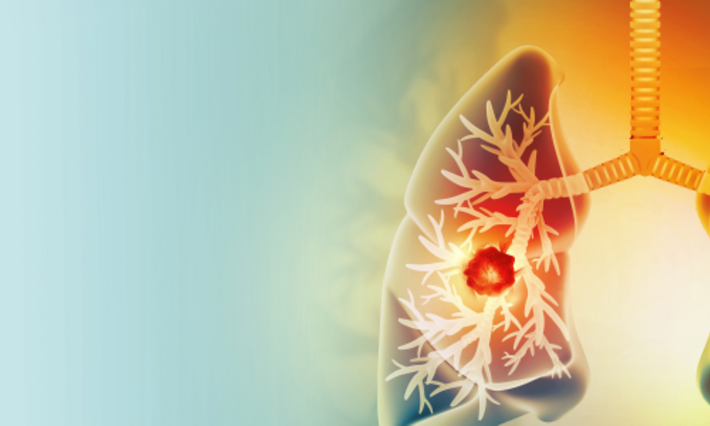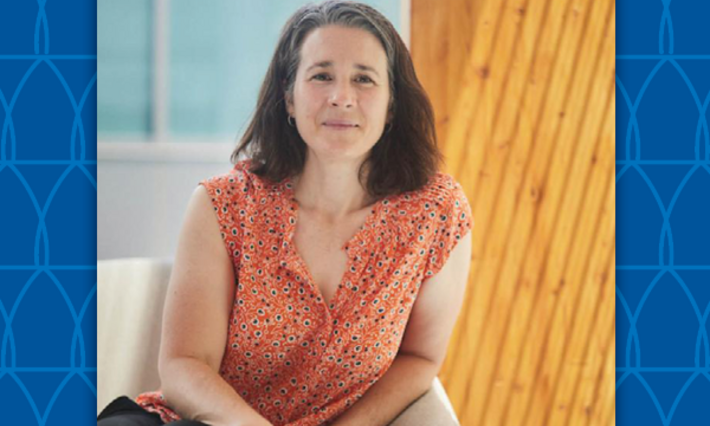On October 12, just before her 66th birthday, Henrietta Carr surprised her care team with a cancer ribbon-themed wall hanging she’d embroidered.
“When I was diagnosed with stage 4 lung cancer, I moved from Greensboro to Durham so I could get treatment at Duke; I just wanted to come to Duke because I think they’re better,” says Carr. “I was feeling hopeless and as I was being treated by Dr. Crawford and Susan Blackwell, I started feeling hopeful of a future. They would share in my happiness, as the cancer would shrink. I am so grateful to my cancer team and wanted to show this gratitude.”
Carr, a mother of two adult children, began embroidering cancer-ribbon-themed wall hangings to support individuals with cancer — friends, friends of friends, family, and friends of family — after she retired from nearly 30 years of service as a clerk and IT specialist for the Social Security Administration. This was well before she was diagnosed with cancer.
“I did about 30 individual pieces and sent them out across the United States,” says Carr, who continued to embroider after her cancer diagnosis. It took about 25 hours to create the 36 by 56 (inches) piece she made for her cancer care team.
To be diagnosed with cancer after bringing so much joy to other individuals with cancer was an unfair turn of events, Carr agrees. “But it is, what it is,” she says.
It’s been nearly two years since Carr’s diagnosis. She’d gone to the Emergency Department at a hospital in Greensboro feeling a little fatigued and hoarse and came out of the ED with a diagnosis of pneumonia, which she was subsequently treated for. However, within a few weeks, she’d lost her voice and was hurting in her chest. Her second trip to the same ED resulted in a diagnosis, by an oncologist there, of lung cancer and pneumonia.
“It was in both lungs and in between my lungs,” says Carr, noting that she wasn’t coughing or experiencing any breathing problems at the time. “I was kind of surprised. Because they kept saying it was (only) pneumonia.”

Stitch in Time: A Lung Cancer Survivor Story
Published
 From the Duke Cancer Institute archives. Content may be out of date.
From the Duke Cancer Institute archives. Content may be out of date.
Not Too Late
In April 2020, she began radiation treatments to her right lung under the care of DCI radiation oncologist Christopher Kelsey, MD. She would also receive various combinations of chemotherapy and immunotherapy. There were promising clinical trial results at the time that indicated that chemotherapy and immunotherapy taken in combination might be more effective than either alone, Crawford explained.
In December 2020, she underwent radiation to her left lung. Since then, she has been on immunotherapy (Keytruda, pembrolizumab) alone.
Carr's specific diagnosis was lung adenocarcinoma, the most common primary lung cancer in America. This particular type of non-small cell lung cancer (NSCLC) has a strong association with previous smoking.
Carr smoked cigarettes. As soon as she learned she had lung cancer, she tried to quit. With the aid of DCI physician assistant and trained tobacco cessation specialist Kelly M. Young, PA-C, she “cut way back.”
“Quitting smoking can be extremely difficult and at times patients may not even know where to start,” said Young. “I value being able to help patient accomplish their goal of quitting smoking by offering medications and counseling based on the most current research.”
People who currently smoke or have ever smoked make up more than 80% of lung cancer diagnoses. Quitting smoking can reduce your chance of developing lung cancer. Even after developing cancer, Young explained, quitting smoking can make cancer treatment more effective and prevent recurrence of cancer or new cancers from developing.
By the end of this year, more than 235,000 new cases of lung cancer will have been diagnosed in the U.S. While the number of annual lung cancer deaths is decreasing, it remains the leading cause of cancer death in the U.S. (not including skin cancer). Lung cancer will take the lives of roughly 132,000 people in the U.S. this year — including about 5,000 in North Carolina — estimates the American Cancer Society.
A Path to Home
More than 75% of lung cancers are diagnosed in people over the age of 65. Carr, 66, has been on treatment for more than a year and a half and is still going strong.
She’s even cheery. She says she feels “much, much, better,” though she admits she doesn’t have a lot of energy.
In September 2021, Carr and her sister Sharlene were able to settle into a new house back in their hometown where they have extended family — in an area down towards Wilmington, not far from the Duplin Winery.
Her treatments have now been extended to once every 6 weeks. She drives an hour-and-a-half to her immunotherapy infusion appointments and clinic visits at Duke Cancer Center in Durham, her sister by her side, and at the end of the day they drive right back home.
“It’s going good. I feel pretty good,” said Carr, who describes herself as a homebody who avoids crowds. “We are just enjoying our house. And staying away from the Delta COVID.”
Susan Blackwell, MHS, PA-C, and Jeffrey Crawford, MD, have been caring for patients with lung cancer at the Duke Cancer clinic for more than 30 years and are more excited than ever about the many treatment options now available.
They work especially closely with primary clinical nurse, Mallory Tassone, BSN, RN, thoracic oncology fellow, Hilary Dietz, MD (who's training in medical oncology), and radiation oncologist Christopher Kelsey, MD, in a team approach for the benefit of their patients.
Susan noted, “Ms. Carr is a wonderful person, always thinking of the needs of others. She is a true lung cancer survivor, living well and living longer.”



